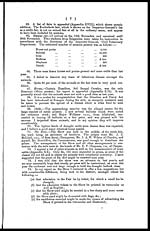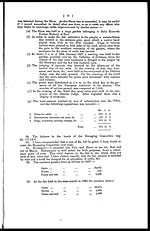Medicine - Veterinary > Civil Veterinary Departments > 1895-1951 - Annual report of the Civil Veterinary Department, Bengal > 1896-1897 - Annual report of the Civil Veterinary Department, Bengal, for the year 1896-97 > Annual report of the Civil Veterinary Department, Bengal, for the year 1896-97
(14) Page 8
Download files
Individual page:
Thumbnail gallery: Grid view | List view

( 8 )
(f) coloured brow-bands with rosettes might be issued to fix on the fore-
heads of prize cattle;
(g) owners of improved cattle to be approached with a view to sending
their animals for show, not necessarily for sale or prizes, but
in order to encourage the people.
75. I may add that I have since discovered, during visits to other fairs
and shows, that there is scarcely one in which some of the above recommen-
dations had not been adopted prior to my report.
76. Kalimpong.—I visited this Fair from the 1st to the 4th December
inclusive. William Dunne, a veterinary student from Darjeeling, was detailed
for instruction. This is an extremely well organized affair under the manage-
ment of Dr. C. F. Ponder of Guild Mission House, a hardworking Committee
and the active patronage of the Deputy Commissioner. The Kalimpong
Committee very wisely combine amusement with instruction in their system,
with the result that a great success was scored.
77. Ponies.—This branch is growing in importance; the number of ponies
and tats shown was double that seen last year. I counted 68 ponies in the
Show. A list of prize-winners is appended (Appendix XXI).
78. For some time efforts have been made to procure two Bhutia pony
stallions for the Burma Civil Veterinary Department, but nothing suitable was
offered and the money has been returned.
79. The prize-winners and a number of the remaining ponies found a
ready sale at an average price of Rs. 240.
80. Tatoos.—Only a few tatoos were shown; they were such poor speci-
mens that no prizes were awarded to them.
81. Mules.—Two-hundred and forty mules were present on the 3rd De-
cember; of these, Captain A. II. Allen, of the Commissariat Department,
purchased, 74 during my stay (vide Appendix XXII). All the animals in the
Show were examined for contagious disease, the mules especially; but experience
teaches that glanders may remain in an occult form for 2 months at least in
India. I wish therefore to add that absolute safety from this disease can only be
guaranteed by submitting all the animals to a test with mallein. Of the Rs. 500
sanctioned by Government from Imperial funds, Rs. 270 only were awarded.
For this purpose, according to precedent, the mules were divided into two
classes, viz., those fit for Artillery and those fit for Commissariat purposes. In
the Artillery class, only one mule came under the existing conditions; it was too
small for Ordnance, but would have made a good Artillery baggage mule and
I gave Rs. 25 to the owner. It was five years old, 13-2½ hands high, girthed
62", girth of shank 6½".
82. I selected the seven best mules in the smaller class and awarded
Rs. 245 amongst the owners (Appendix XXIIA).
83. The information at present before me rather favours a system of
competition open to all the mules in the Show, as being more closely in accord-
ance with the objects for which the money is offered.
84. A promising source for the supply of mules has been found at Kalim-
pong, but there is still room for improvement in quality. It has been suggested
that good donkey stallions might possibly be made available for the use of
Thibetan breeders.
85. Cattle.—The cattle were better in quality and more numerous than last
year. There were three kinds: the Siri or large breed, a small breed called
Paharis, and a cross between the two called "Siri katchas." My predecessor,
Captain Gunn, reported upon this subject in his last annual report.
86. I have recommended that the Imperial grant of Rs. 500 to encourage
mule breeding may bo renewed next year.
87. Suri.—This was the first cattle fair held in the district, and thanks
to thorough good management and great energy on the part of all concern-
ed, and especially on the part of Dr. G. Fleming, the Treasurer, the
Rev. J. P. Meik and Babu Chandra Gati Mustaphi, it went off in a way that
must have surprised the most optimistic.
88. The Show was instituted by Mr. Drake-Brockman to encourage the
improvement of cattle, ana it was not to be expected that any exceptionally
fine specimens would be seen, but some of Mr. Meik's half-bred Hansis were
good. I append a list of prize-winners (Appendix XXIII). No case of disease
Set display mode to: Large image | Zoom image | Transcription
Images and transcriptions on this page, including medium image downloads, may be used under the Creative Commons Attribution 4.0 International Licence unless otherwise stated. ![]()
| Permanent URL | https://digital.nls.uk/76341265 |
|---|




